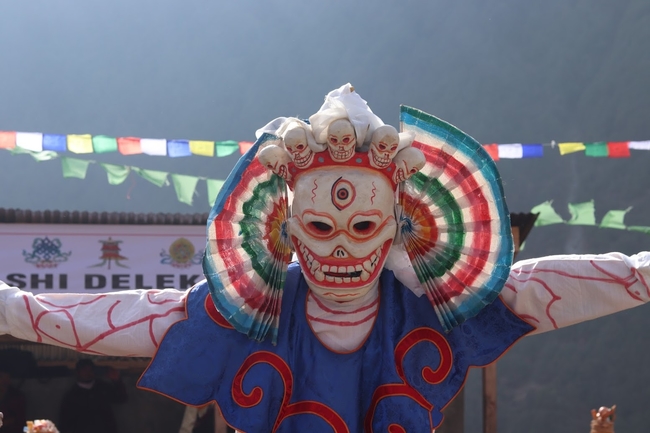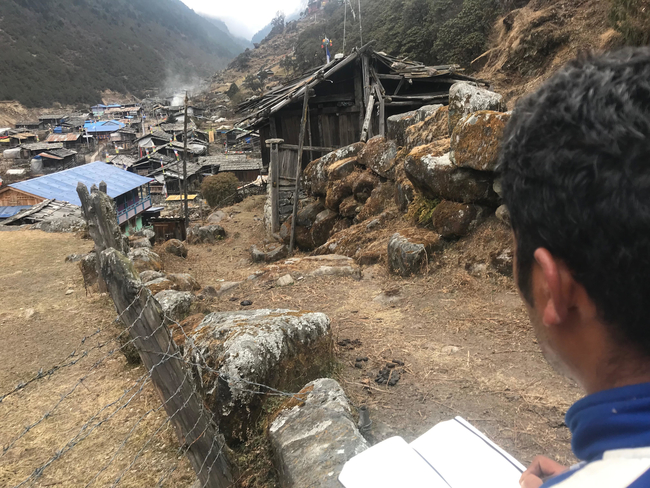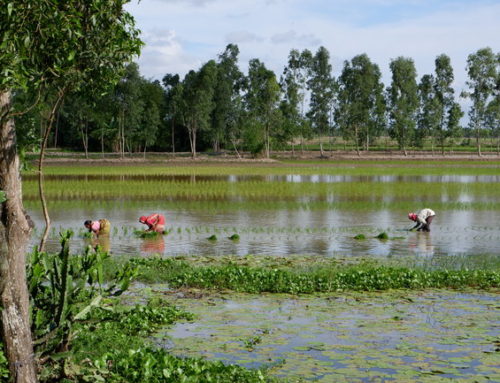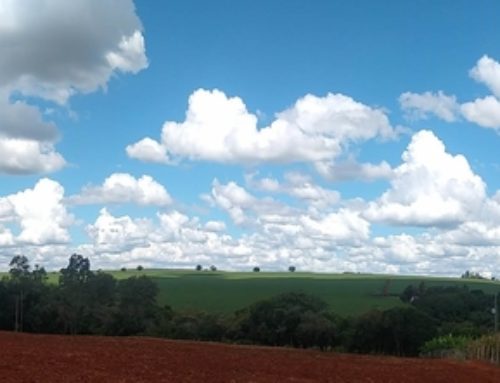The little bee that enjoys flower sap would not like to leave the beautiful garden,
but when the icy wind suddenly sweeps in at the end of autumn,
it has no choice but to let weariness linger in its heart.1
-Jigme Phuntsok
“Drew, careful here.” Tseten points at a pile of rubble along the tree trunk on which we are balancing and walking slowly. I yell ahead, “I see there. If I fall, I will meet the shimkyoug [skeletons]!” We both erupt in laughter. Tseten and I have been trekking together for nearly two years in the eastern Himalayas. He and I often sit and laugh drinking tongba in the village making small talk and joking.2 Now, he is helping me go trek out to get help for my injury. My reference was to the dancing skeleton duo from a festival that took place a month earlier in his home village. Being able to joke, while in extreme pain, using local references, makes me feel accomplished. Then I slip, pain shoots down my leg, and I sit down. This trail from the village of Olangchung Gola to the village of Tapethok is one of the roughest paths in the eastern Himalayas. Snugged in at the foot of the world’s third highest mountain, Kanchenjunga, the entire valley system makes up Asia’s first decentralized community-run conservation area. My dream research has been on the wolves of Nepal and all sorts of multispecies questions that I feel need to be answered about conservation in the Anthropocene. But all of that has already become precarious, and I don’t even know about COVID-19 yet.
Two things slow Tseten and I down. The first and most important is that a couple of weeks earlier I badly injured my back and left leg while hiking near the Tibetan border. My fieldwork is supposed to be about wolf and yak herder conflict in remote villages and camps in eastern Nepal. But today my only goal is getting back to the road and the larger city of Taplejung safely. My wife is worried. The second reason we are slow is because of Chinese-Nepali development. The Chinese are building a road through the conservation area. The road pretty much follows the millennia old trail system, but the tactics used are brutal. Bulldozers and large machines churn through the forest and rocks daily. This causes massive landslides and treefalls over the paths. My back and leg make me weak and unsteady without the added need to balance on massive fallen trees or to keep my feet planted on jagged rocks a few hundred meters above the river below and the certain drowning death that would come with a fall. Yet, our sprits remain calm and even happy. We have hiked this trail many times before. However, as we walked, I did not know that this hike down with Tseten may be our last one for some time to come.

“One of the Shimkyoug, protectors of the dharma.” Photo by author
Human beings desperately clinging to this life — When you see the wild-eyed messengers of the Lord of Death, and recall how carelessly and distractedly you’ve spent this life, isn’t it too late for you to bitterly repent at that final moment? 3
A few months before, the village of Olangchung Gola and the Walung community in Kanchenjunga celebrated the festival of Phutuk. Theirs is a local version of a Tibetan Buddhist festival. My joke about the skeleton duo—one of my personal measures of ethnographic success—lands so well because its about one of the dances in the Phutuk festival. In the dance, the skeletons re-enact trying to take a baby, umbilical cord and all, from a prone man. Initially I thought the whole thing was a metaphor for death, but its actually about rebirth. When I asked about the skeletons, a monk told me, “You see them so that when you enter death you will not be scared.” The skeleton masks and the intricate dances seem ominous at first glance, but the scary looking deities are actually there to scare away other demons who may disrupt the dharma. The skeletons are there to remind you to not be fearful at the moment of death. For me, a novice initiate into Nyingma Tibetan Buddhism at the lowest level, they are slippery metaphors. But, they are also very real and they teach penultimate lessons about the nature of our shared fleeting moment as sentient beings. This realization helped me to walk with pain for six days and to keep quiet about it.
Two months later COVID-19 has enwrapped all of humanity’s consciousness and I am trapped in a 600 square foot apartment in downtown Bangkok. Luckily my wife is with me; we have enough food, we have the internet for reaching out, and we are warm and safe. My back injury required one month of physical therapy only available in Bangkok. So, we packed up a small amount of our belongings, then left almost all of our possessions in east Nepal, and headed out. Our plan was to return to Nepal on March 1st. In Kathmandu before we left, I had a moment of lucky hesitation. I looked at my fieldwork notebooks, deciding whether they should stay or come with me. I decided to go ahead and pack most of them to read through while I was recovering out of the country. But most everything else, including hundreds of dollars of field equipment, most of our clothing, and all of the other myriad things like jewelry, small art objects, and other random things that make up living overseas are now waiting for our return with various friends in Nepal. These are things that can be replaced. I have already told all my friends in the remote areas to use all my equipment and use all of the stored food I had bought for the spring/summer season with the high herding communities. We miss our friends beyond words. During these heady days feeling depressed about missing ethnographic fieldwork smacks of ostentatious privilege. At even its best moments Western-based cultural anthropology has a slight whiff of the bourgeoisie in it. To be sure, that is certainly changing as the generations slowly turn over. And, replacing any real worry about what my fieldwork may still be able to accomplish are my personal worries about the human beings who have trusted me with their own life stories.
What do we do now with stories from people that still feel incomplete? What does it mean to now be stuck far from the “ethnos?” The world shifted its axis and fieldworkers slipped away from their sites. A real feeling of connection has turned into worry. For me, and also for my wife who was working in Nepal, this feeling is rooted in real fear for the people we love in Nepal. If the richest countries on the planet cannot deal with COVID-19, we worry that one of its poorest will not fare well. And yet, we are torn asunder in two directions at once like so many anthropologists elsewhere around the world. Our home is where our families are, in the United States of America. Our passports say we belong there. Governments across the globe, including Nepal which smartly sent everyone away and even Thailand which is allowing us to shelter in place indefinitely, say the USA is where we eventually belong during the COVID-19 pandemic. And yet, we watch with trepidation daily as our own country falls apart at the tenuous seams glued together through years of capitalist logics. I feel depressed about missing fieldwork, yet I feel anxiety and compassion when I fill my mind with the voices of those I love so far away in both Nepal and the USA. How many other fieldworkers are also stuck in-between?
In some ways, feeling powerless is part of the grand bargain of going to graduate school in the humanities. Now, however, anxiety and depression are doubled by slipping into these bureaucratic no-spaces where an individual’s passport and academic imperatives count for less than the sum of the US student debt. The difficulty of being in the field in the first place is exacerbated by now not being able to move anywhere with any confidence that you won’t get stuck again, or even die trying. This, of course, was the situation for most of humanity before the pandemic. An inequitable distribution of resources, asymmetrical political systems, and modes of production hinging on exploited workers have always trapped and sentenced vast swaths of humanity to slow deaths. The reason I know this in some detail is because, among other things, I was taught a decade’s worth of detailed ethnography. What is the fuel for our academic minds being disciplined in the discipline? Ethnography is that fuel. Ethnography is the sunshine, the moving water of information that drives, for better and worse, the entire academic discipline of anthropology. Where does this fuel come from? From us. From precarious student fieldworkers in the process of “becoming” PhD-degreed anthropologists. Given this, what is in danger of being lost, and what might we think about reconstructing?
Shooting Dye Into our Episteme: Or, Avoiding Ostentatious Doubt
While I was hobbling down mountain trails for almost a week, COVID-19 had already begun to claim lives in China. I was only twelve miles from the Tibetan border and moving further each hour on foot. Distances were collapsing in real time. My own pace—half that of a healthy Sherpa man on the best of days—had degenerated like my bruised leg and herniated disc to a fraction of what it could be. It was only due to Tseten and his daily encouragement that I even made it out in reasonable shape. When I arrived in Taplejung the news only briefly mentioned something about China. We felt confident to leave Nepal to get a months’ worth of health care in Bangkok, then return to finish the last six months of fieldwork. COVID-19 had other ideas. The virus erupted and we ended up stranded in Thailand. What can I see now from this rapidly shrunken view? When I left Nepal, COVID-19 was already showing the ways in which suffering can become an atherosclerotic agent on the very human trails and routes I was moving along in my own suffering. Martin Saxer calls the entirety of these life ways and their connections in rural east Nepal “pathways” (2016). These pathways, like the trail I sat on waiting while trees were being felled ahead, show how culture and human corporeal actions across landscapes shape and in turn are shaped by history, ecology, and ever shifting social realities and contingencies.

What’s important for my thinking now is asking what fuels these sorts of insights and theoretical assemblages? For starters, it is, as with everything, rooted in labor. Specifically for our concern here, it is the labor of unpaid, non-tenured, PhD candidates that makes up the brunt of the theory-building, longform ethnographic work done every year. And most of us, if not all, are now stuck in liminal spaces not doing our proscribed projects. It would be interesting to know just how many PhD candidates are in the field at any given time in anthropology. Regardless of their number, our insights and eventual journal articles and books are the fuel, the sunlight, the messy mulch of the entire ecosystem of the episteme of ethnography. It may seem obvious at this moment to point out that, up until COVID-19, most of us were already researching culture in a precarious neoliberal zeitgeist. I am stuck in Bangkok, but the reasons are linked to more than the virus. In the USA, I had to un-enroll from my university to do fieldwork due to the non-negotiable university requirement I enroll in thousands of dollars’ worth of dissertation credits to remain a student in good standing. Grants, scholarships, and the like usually do not cover tuition on top of fieldwork. So, most of us un-enroll. Of course, the situation may be different at other universities, especially at elite schools; I’d be interested to know. At any rate, there is a plus to un-enrollment.By not being enrolled I am able to spend and move freely and not go bankrupt using credit cards to pay for credit hours while not on campus. The downside is that we have no health insurance or housing in the USA. During fieldwork, this is usually not a big deal. Until now. If my wife and I return to the USA, we land in the middle of the largest COVID-19 outbreak in the world with no health insurance, no safety net from the university, and no housing. We will be one Emergency Room visit away from bankruptcy on top of student loans. So, we remain happily in lockdown in Bangkok. I am certainly not the only one caught in this situation, many other PhD candidates are as well. We do not know if we can finish our fieldwork, or if it will be deemed worthy. We do not know if the act of coming home will bankrupt us as the institutions that sent us out cannot guarantee us a job in the future. The only bright side for me at least has been an attentive, empathetic, active mentor and advisor. Some are not so lucky. Sometimes it seems out of touch to worry about these things while poor people die for lack of ventilators in public hospitals. However, this specific academic precarity is all part of the same system that is now becoming visible in stunning ways as the days go on. If we care about fieldworkers and the production of ethnographic insights, we should also care for the political economy that constrains the production of knowledge that the academy would wither and die without. Our future books, our future stories, the very writing that collaborators count on us doing truthfully is in limbo. It is not the most important thing in the world. It is the furthest from it. But maybe this space is one from which we can warn of the coming debates and the worry in the back of our minds. Our families need to breathe without disease first, then we all look to our future as workers. Anthropologists, especially the secure, should worry about the loss of the fuel that feeds the fire of our inquiry. Like the reality of fieldwork and neoliberalized precarity, the ongoing labor issues among graduate workers in the time of pandemics will have to be faced. The good news is, I think, the hardening of our pathways of knowledge can be formative in our sensing of problems.
The only metaphors that work for me now are ones for diagnosis. I worked for my entire twenties and early thirties in emergency medicine. One of the most fascinating medical tests that can be done is angiography. In this procedure a radioactive dye is safely shot into the arteries. A real time x-ray then shows where the twists, malformations, and blockages in the patient’s arteries are. All of this happens in real time. Nurses and doctors stand and watch this occur on screens in front of them. Even the patient is awake. This is our moment now and we should not let it pass. We need to stay awake. The hardening of our political economic and social arteries began a long time ago. The production of ethnographic knowledge hit many clots and caused many symptoms that are now being brought forward. COVID-19 is showing us in real time where we can make interventions. It is showing where our labor needs oxygenated blood, and where we need to intervene, to decolonize, to re-arrange, to reassess.
To question my own fears and doubts about being a stuck ethnographer due to COVID-19 is an ostentatious zero sum game. There is only so much energy that a fieldworker has on a daily basis. When our instrument, our very bodies, are removed from contact with the people, the sounds, the smells, the cycles of life we love and want to render visible and honor, then fears can set in. Ethnographers without the anthros and the cracking, electric ethnos can feel like jobless hairless voles wandering blind. Some days it feels like all I do is scratch the walls and flip through channels in this apartment in Bangkok wishing to be back in the mountains for just one precious moment. However, at this point I can’t afford ostentatious doubt, and I hope other liminal fieldworkers know that too. We are all in the field now, we are all ethnographers in our own homes and in the moment we walk outside. Perhaps the field as a space is collapsing on itself. Perhaps opportunities again are emerging.
Danger remains however. I cannot, and do not, in the age of COVID-19 want to constantly be the “ethnographer” as a persona. In the field doing “deep” hanging out I felt myself becoming more and more a person who is a friend, but also at the same time ironically becoming more of a professional ethnographer. Interview and observation skills sharpen along with linguistic and social abilities over time. To suddenly, abruptly, be torn from this world can be jarring. It can lead to depression. The internal outlook has to be balanced, but I’ve had a hard time adjusting. I wonder who else has? It is hard when we hear so little from other fieldworkers scattered across geographies of technocratic disease management. Personal anxieties triggered by incomplete information and powerlessness can percolate into depression and rage in plague times. I worry daily about the anxieties in our communities in the USA shapeshifting into destructive emotions. As anthropologists, and as PhD candidates stuck in our research, maybe we can try to show some of the long duree about the nature of suffering and joy. I don’t know what that looks like yet. We do have a complicated, complicit, both bad and good canon to mine however. We also have each other who have been out there in so many places and so many ways.
In a month, this essay may feel quaint, ill-informed, and even Pollyannaish. What I write in a month may look like all those things in a year. Do we still need to write? Yes. Our attempts at being transparent and diagnosing our concepts of fieldwork and ethnographic praxis will be incomplete, often wrong, and seemingly out of touch in the future. In the time of COVID-19 though, we owe the historical record our honesty in hermitage. Our anthropological imagination has to meet the future. A future that today, March 27th 2020, from an apartment in Bangkok, without a dissertation project, seems difficult to imagine. All I have today are dozens of notebooks filled with sketches of another world. It is a comfort to know that all of us have the same daunting task ahead. We must use our newly shattered ethnographic pathways to replenish and buttress the stories and truths humanity could use at a time like this.
Notes:[1] From “Always Remembering: Heartfelt Advice for Your Entire Life” by Jigme Phuntsok.
[2] Tibetan-style alcoholic drink. Made with fermented millet that you put in a bamboo vessel (or perhaps just a plastic jug), pour hot water over, and drink through a bamboo straw. Worth its own book of essays. It’s that good.
[3] This is literally the next stanza in Jigme Phuntsok’s poem that opened this essay.
References:
Phuntsok, Jigme. 2019. Always Remembering: Heartfelt Advice for Your Entire Life. Simon and Schuster.
Saxer, Martin. 2016. “Pathways: A concept, field site and methodological approach to study remoteness and connectivity.” Himalaya: The Journal of the Association for Nepal and Himalayan Studies, 2, 104–119.
Cite as: Zackary, Burditt. 2020. “Walking in Metaphors: Snapshot of a Fieldworker in the Time of Covid-19.” In “Pandemic Diaries” Gabriela Manley, Bryan M Dougan, and Carole McGranahan, eds., American Ethnologist website, 27 March 2020, [https://americanethnologist.org/features/collections/pandemic-diaries/nepal-walking-in-metaphors-snapshot-of-a-fieldworker-in-the-time-of-covid-19]
Burditt “Drew” Zackary is a cultural anthropology PhD candidate at the University of Colorado. His research focuses on multi-species conflict in Nepal.



